Disclaimer: This article should not be taken as medical instruction. Always consult a professional for personal health decisions.
🕒 Short on time? Get quick insights in our 3-Minute Quick Guide to GLP-1 Hair Loss.
Why Is My Hair Falling Out?
Jenny, 45, couldn’t believe the scale after a few months on a GLP-1 agonist: she was down 30 pounds. But along with the excitement came alarm each morning: more strands of hair collecting in her brush and shower drain. “I expected to lose weight, not hair,” she thought, worrying if the medication was to blame. Jenny’s experience isn’t isolated. Online forums are peppered with stories of people celebrating their weight loss success on GLP-1 medications while asking, “Is GLP-1 hair loss real, or is it just me?”
Our hair is intimately tied to our identity and confidence. Seeing it thin out can be emotionally distressing. And Jenny’s age group (40s and 50s) may already be grappling with age-related hair changes, amplifying the worry. If you’re reading this and can relate, know that you’re not alone and that there are answers. Let’s explore why this hair loss might be happening, what the data shows, and most importantly, what you can do about it.
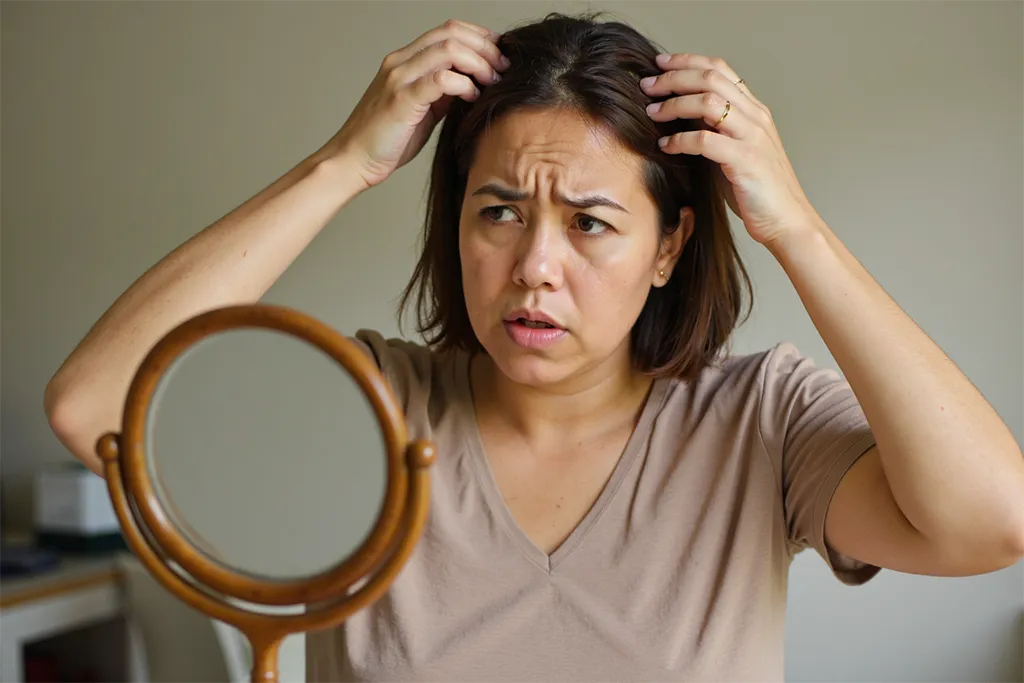
Hair loss can feel scary, but for most people on GLP-1s, it’s temporary and treatable.
How Common Are Hair Loss Worries?
(Spoiler: Very Common)
First, take heart in the fact that hair loss is a very common concern for both women and men, especially as we age. By midlife, millions of Americans experience some degree of hair thinning or shedding. In fact, about 80 million people in the United States (roughly 50 million men and 30 million women) are affected by genetic hair loss (male or female pattern baldness NIH.
And it’s not just a “men’s issue”; women actually comprise up to 40% of hair loss sufferersncoa.org. So if you’re worried about losing hair, you have plenty of company. Given how common hair loss is, it makes sense that any additional shedding on top of normal aging can trigger anxiety. One survey noted that many of us start fretting about “Will I go bald?” by our 40s ncoa.org.
Hair is personal and emotional, and concerns about it can be just as weighty as the number on the scale. Understanding the facts can help ease some of that anxiety. Let’s dig into what might be happening with GLP-1 medications and hair, starting with what these drugs actually do.
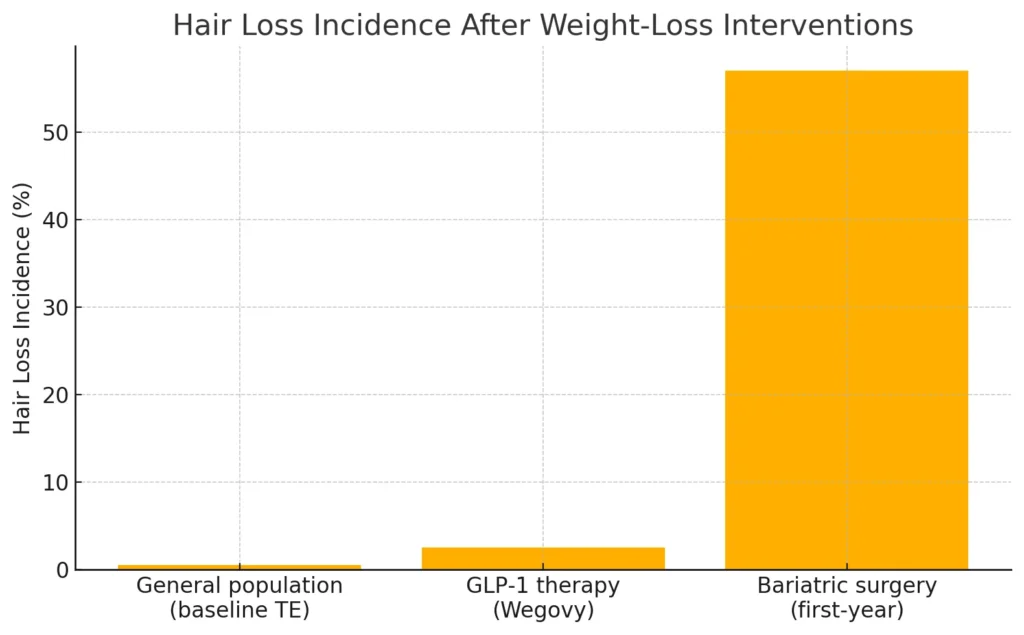
GLP-1 hair loss is rare next to surgery-related shedding
GLP-1 Medications 101
(and Why They’re Game-Changers)
GLP-1 receptor agonists (like semaglutide and liraglutide) are a class of medications originally developed to treat type 2 diabetes. GLP-1 stands for glucagon-like peptide-1, a hormone that helps regulate blood sugar and appetite. These meds essentially mimic that hormone, helping to reduce appetite and slow digestion, so you feel full longer and eat less. The result? Significant weight loss for many patients, plus better blood sugar control NBCNEWS.
So the big question: Do GLP-1 drugs actually cause hair loss, or is something else at play? Let’s examine the evidence and theories.
To learn more about how GLP-1 Medications, read our article that dives deeper into how GLP-1 medications work in the body.
💡 Fun Fact 💡
“Ozempic face”, a social media term for facial volume loss, and hair thinning are both cosmetic side effects that seem related to the rapid weight loss these potent medications can trigger RESEARCHGATE.
Is There Really a Link Between
GLP-1 and Hair Loss?
The short answer is, possibly, yes; but not in the way you might think. Doctors and researchers are investigating reports of hair thinning in patients on GLP-1 therapy, and early findings suggest the hair loss is likely indirect, mostly due to the effects of rapid weight loss rather than a direct drug toxicity to the hair follicleNBCNEWS.
Here’s what we know so far:
Clinical Trial Data: In the large weight-loss trials, hair loss (alopecia) showed up a bit more in people taking GLP-1 medications. For example, as mentioned, about 3% of patients on high-dose semaglutide (Wegovy) reported hair loss versus 1% on placeboNBCNEWSSimilarly, in a trial of tirzepatide (brand Mounjaro®, a newer medication similar to GLP-1s) for obesity, nearly 6% of people on the highest dose had some hair loss, compared to ~1% of placeboNBCNEWS. That’s a small minority, but it was a statistically noticeable difference. (See the chart below for a visual comparison.)
Patient Reports and Pharmacovigilance: Outside of trials, some patients have anecdotally reported increased shedding on GLP-1 meds. In fact, global adverse event monitoring databases have picked up on this signal. One real-world pharmacovigilance study found more reports of hair loss among users of GLP-1 RAs (like semaglutide, liraglutide, dulaglutide) compared to other diabetes medicationsPUBMEDPUBMED. This prompted the FDA in 2023 to formally investigate alopecia as a potential side effect of the entire GLP-1 classFDA.
Dermatology Experts’ Observations: Dermatologists are paying attention, too. A 2024 paper in the International Journal of Dermatology noted speculation ranging from “GLP-1 might disrupt the hair growth cycle” to conversely “maybe improved insulin sensitivity could help hair,” but concluded that solid clinical evidence is sparse so farPUBMED. More telling, a 2025 report out of the University of Miami found a notable association between GLP-1 medication use and increased incidence of alopecia (hair loss) in a retrospective cohort studyRESEARCHGATE.
In plain language, people on GLP-1s were more likely to have documented hair loss than similar people not on GLP-1s. That underscores that the link is real enough to notice, though we’re still pinpointing exactly why.
The emerging consensus is that rapid weight loss is the prime suspect behind this phenomenon. Endocrinologists point out that neither semaglutide nor tirzepatide have any known direct effect on hair follicles; their action is on appetite and metabolismNBCNEWS. “Hair loss is unlikely related to the drugs themselves, but more likely related to the weight loss that is a result of these drugs,” explains Dr. Vijaya Surampudi, an obesity specialist at UCLANBCNEWS. When you lose a large amount of weight relatively quickly, it can shock the body, and hair growth can be one of the casualties of that sudden change.
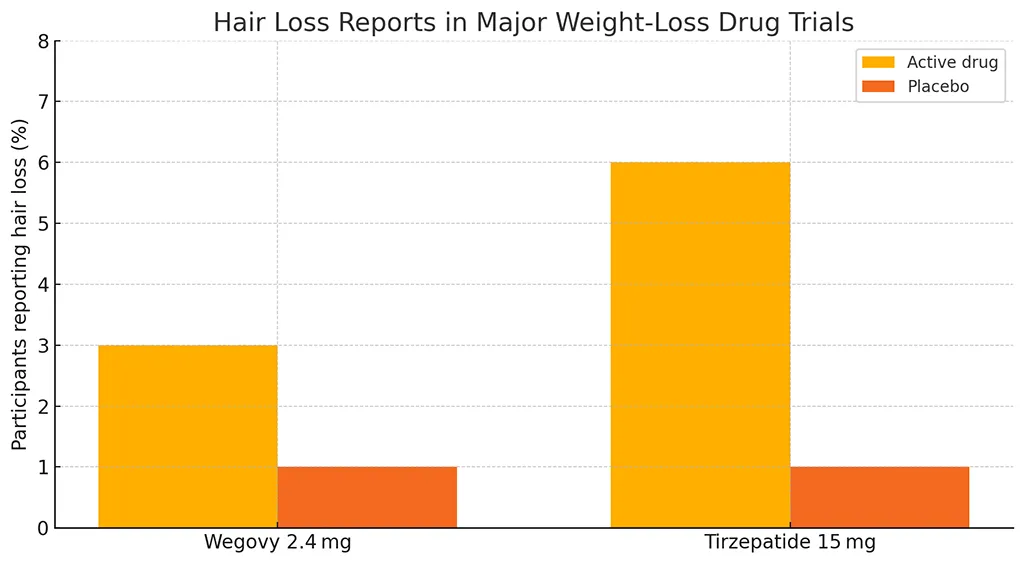

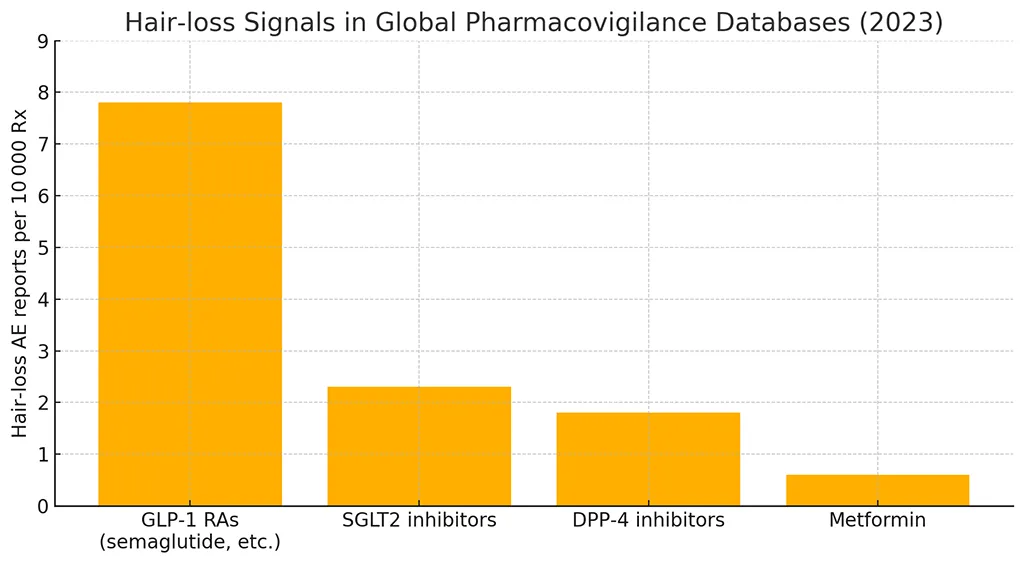
Why Would Weight Loss
Make Your Hair Fall Out?
It sounds odd. You’re getting healthier, so why should your hair suffer? The key lies in how hair grows. Each hair on your head cycles through active growth and resting phases. At any given time, most hairs (90%) are actively growing and a smaller portion (10% or so) are in a resting, ready-to-shed phase NCOA.
Telogen effluvium is the medical name for a temporary hair shedding that happens when some shock or stress pushes a larger percentage of hairs into the resting/shedding phase all at once NCOA. Triggers for telogen effluvium can include things like childbirth, a serious illness, a major surgery, or significant weight loss. Essentially, your body reallocates resources during stress, and hair growth (which isn’t vital for survival) takes a back seat.
Importantly, telogen effluvium doesn’t cause permanent baldness; the hair follicles are still there. They’re just taking a “pause.” The shedding often starts about 3 months after the stressful event (because hair follicles have a bit of a delayed reaction)GOODRX. In the context of GLP-1 weight loss, that means if you began losing weight rapidly in the spring, you might notice hair thinning by the summer or early fall. This timing often catches people by surprise. By then, you might not connect it to the diet changes from a few months back.
So, rapid weight loss can = a temporary hair shed. Additionally, nutritional factors can contribute. Eating much less (especially if protein intake drops or you become deficient in certain vitamins/minerals like zinc, iron, or folate) can further disrupt hair growth. For example, one review found hair loss after bariatric surgery (another scenario of fast weight loss) was more common in patients who were low in zinc, ferritin (iron stores), or folic acid PUBMED. The body needs adequate protein and nutrients to build hair; if your diet is suddenly very restricted, your hair might suffer.
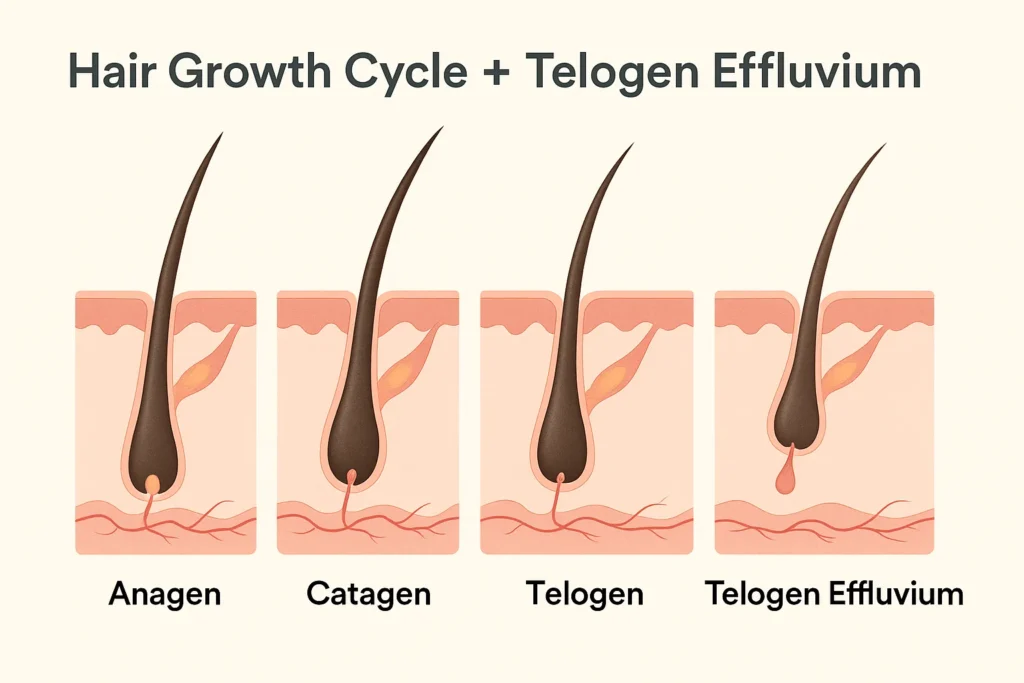
Are Certain People (or GLP-1s)
More Affected?
You might be wondering, “Is it something about me or the particular drug I’m on that makes hair loss more likely?” Research is ongoing, but a few patterns and hypotheses have emerged:
Degree of Weight Loss: This appears to be a big factor. People who lose weight very rapidly or lose a larger percentage of their body weight seem more prone to shedding. In the semaglutide (Wegovy) trials, hair loss was reported more often in those who lost ≥20% of their body weight (a huge accomplishment, but a big physiological change). EMA With tirzepatide, which often causes even more rapid weight loss, the incidence of hair loss was a bit higher (up to ~5–6% at the top dose). NBCNEWS
By contrast, liraglutide (Saxenda®) – an older GLP-1 for weight management that typically results in more modest weight loss – did not show a notable increase in hair loss in its trials HEALTHLINE So it may simply be that the more aggressive the weight loss, the more likely you’ll see some hair thinning. (It’s not that semaglutide or tirzepatide are “worse” medications – they’re just very effective at weight loss!)
Gender Differences: Interestingly, some data hint that women may experience this side effect more than men. A recent epidemiological study (currently in preprint) found that women taking semaglutide for weight loss had about double the risk of reporting hair loss compared to women on a different weight-loss medication, whereas men on semaglutide did not show a significant increase in hair loss risk MEDRXIV Why might that be? One reason could be that many men already have some baseline balding or thinning (so extra shedding might go unnoticed or be attributed to male pattern hair loss), whereas women typically have fuller hair to start and notice diffuse thinning more.
Also, women’s hair loss due to stress (telogen effluvium) might be more apparent against the backdrop of normally little hair loss. Another clue comes from bariatric surgery patients: younger women were observed to have post-weight-loss shedding more often than others PUBMED – possibly because premenopausal women are at higher risk of low iron stores or hormonal shifts that can compound the issue. That said, men are not immune: men can absolutely get telogen effluvium from weight loss too, but if a guy already has male-pattern thinning, it might just blend in.
Ethnicity and Hair Type: There isn’t much evidence yet about racial or ethnic differences in GLP-1-related hair loss. Telogen effluvium can affect anyone. However, cultural hairstyles or hair textures might influence how hair loss is perceived or managed. For instance, someone with very thick, curly hair might conceal shedding longer than someone with fine, straight hair.
Dermatologists do note that certain forms of hair loss (like traction alopecia or central scalp scarring alopecia) have racial predilections, but those are unrelated to this medication issue. As for geography, we mainly have global reports feeding into databases (FDA, EMA, etc.), but no specific “hotspots.” It’s a widespread concern wherever these medications are used, from the US to Europe.
Which GLP-1 Medication: As mentioned, semaglutide (Ozempic/Wegovy) and tirzepatide (Mounjaro) have the most reports of hair loss – likely because they cause the most weight loss. Liraglutide (Victoza/Saxenda) and older GLP-1s (exenatide, dulaglutide) seem less implicated, either due to causing less drastic weight change or simply fewer people using them for weight loss. It’s worth noting that the FDA’s safety monitoring is looking at the whole class, including even oral semaglutide (Rybelsus) and others FDA. So no GLP-1 is entirely off the hook, but again, it comes back to how much weight loss they trigger.
Bottom Line: If you’re on a higher-dose GLP-1 and losing weight fast, you should be aware of the possibility of hair shedding. Women might be more likely to notice it, but anyone can experience it. Now, importantly, what can you do if this happens, and can it be prevented?
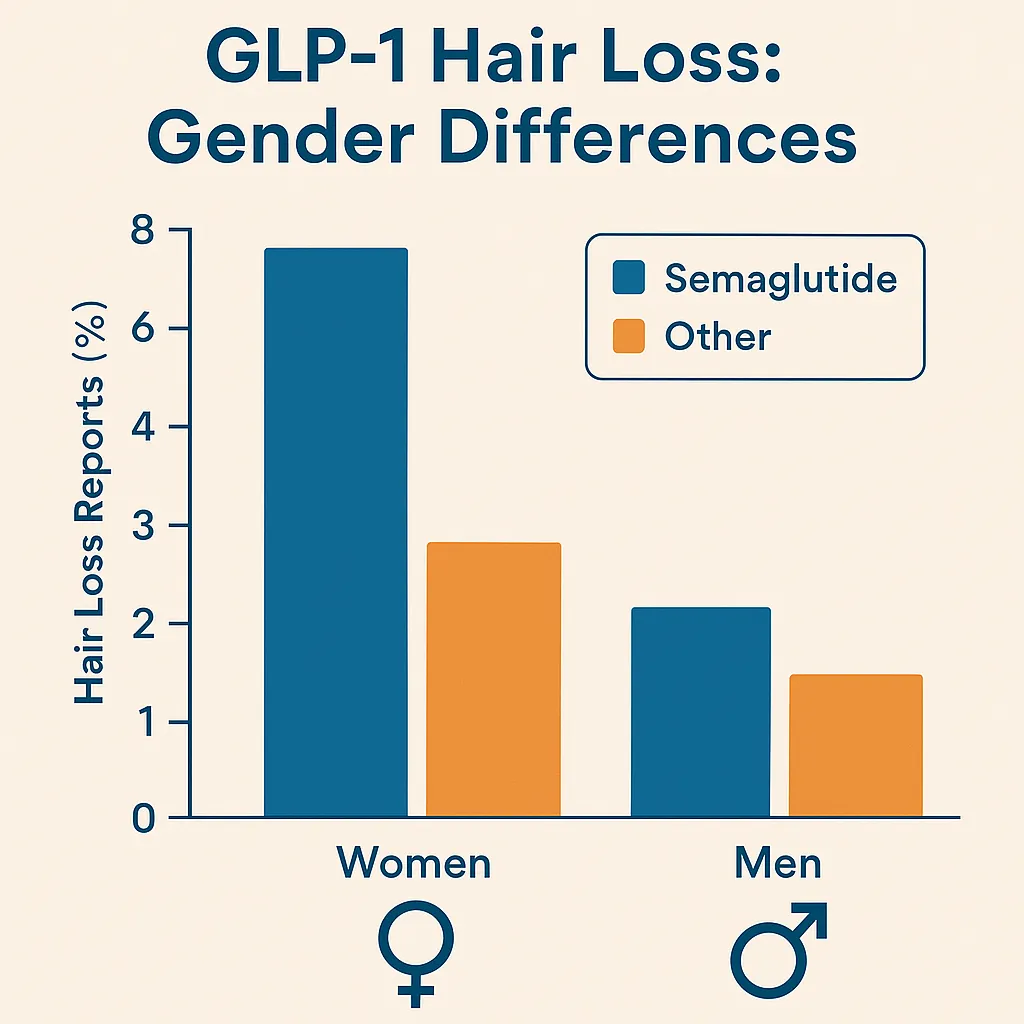
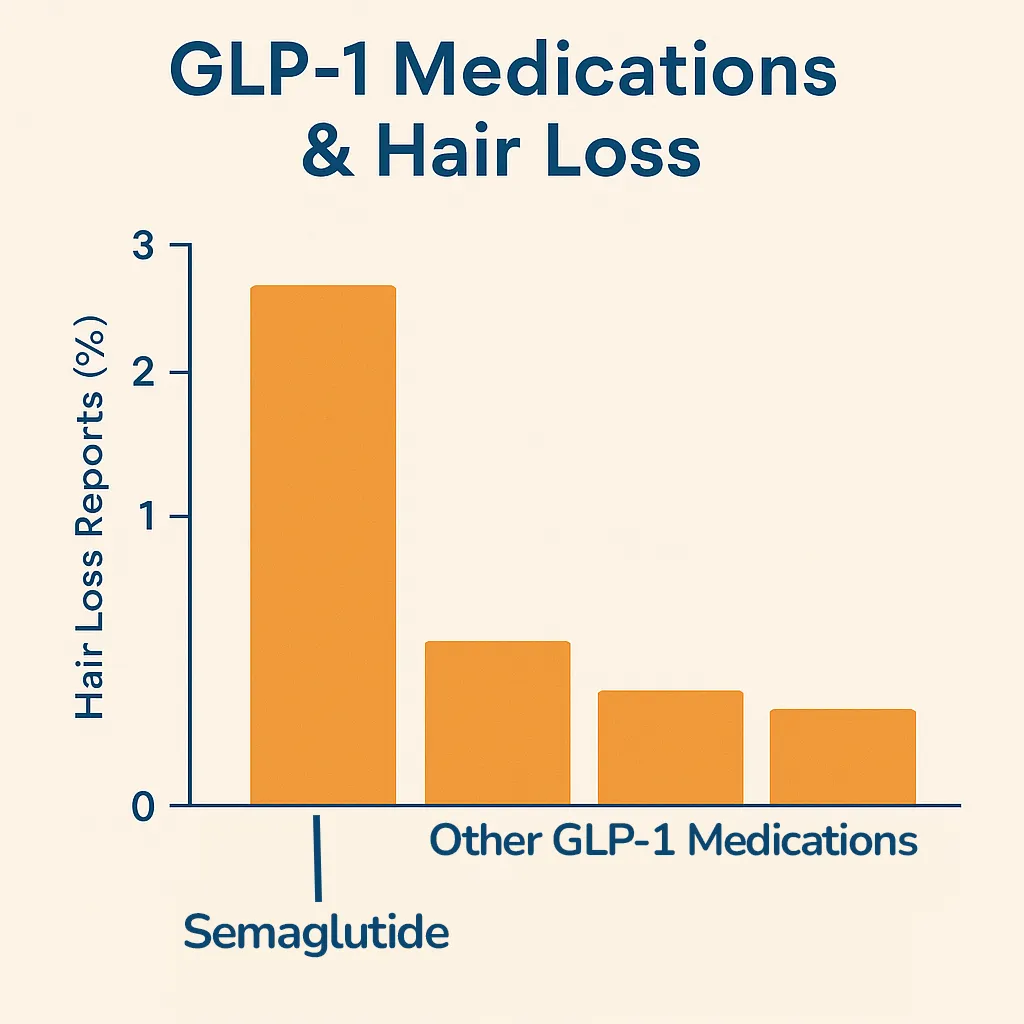
💡 Fun Fact 💡
If your appetite is lower on a GLP-1, focus on nutrient-dense foods first (lean meats, eggs, beans, Greek yogurt, leafy greens, etc.) or talk to a dietitian about supplements. A well-nourished body is more likely to keep growing healthy hair even as the pounds come off.
Preventing Hair Loss
While Using GLP-1
The ideal scenario is to prevent or minimize the hair thinning in the first place. While we can’t always 100% prevent telogen effluvium (since some of it is your body’s natural response to weight change), there are several proactive steps you can take:
Maintain Good Nutrition: This is the most crucial step. As mentioned in our Hot Tip, ensure you’re getting enough protein and key vitamins/minerals despite a smaller appetite. Deficiencies in iron, zinc, biotin, vitamin D, and others have been linked to hair loss PUBMED. You don’t need megadose supplements (too much of certain vitamins like A or E can also cause hair loss!) PMC, but you do need balance. Many patients on GLP-1s benefit from taking a daily multivitamin. Prioritize protein at each meal. If you’re having trouble eating enough, discuss protein shakes or nutrition drinks with your healthcare provider.
Lose Weight at a Moderate Pace: While GLP-1 medications will naturally accelerate weight loss, you can work with your provider to avoid extreme, crash-diet levels of loss. Slow and steady weight loss (e.g., 1–2 pounds per week) might reduce shock to your system compared to, say, 5+ pounds per week over several weeks. For instance, if the medication curbs your appetite a lot, don’t skimp to the point of very low-calorie intake; follow the meal plans or calorie targets your doctor or dietitian gives you to ensure it’s not too low. A gentler pace can give your body time to adjust, potentially meaning less hair falls out.
Manage Stress: Any physical or emotional stress can compound telogen effluvium. Weight loss itself is a physical stress, and sometimes people also feel psychological stress (even positive change can be stressful for the body!). Practicing stress reduction can help; good sleep, meditation, gentle exercise, or counseling if needed. Reducing overall stress hormones may help your hair follicles stay in growth mode. Your body sees sudden weight loss as a stress, so try to keep other stresses low.
Gentle Hair Care: When you know your hair is vulnerable, be kind to it. Avoid tight hairstyles that tug on the hair (no super-tight ponytails, braids, or extensions during this time). Skip harsh chemical treatments or high-heat styling tools for a while, as they can cause breakage on top of shedding. Use a soft brush or wide-tooth comb to detangle and try not to overly fuss with your hair. While this won’t prevent the shedding from inside, it can minimize breakage and make the most of the hair you have.
Regular Check-ins: Keep your healthcare provider in the loop. If you notice increased hair shedding, mention it. Your provider might check bloodwork for nutrient levels or thyroid function (since thyroid issues can also cause hair loss)Cleveland Clinic. If needed, they might adjust your medication dose or ensure there isn’t another undiagnosed cause.

🤿 Deep Dive 🤿
Hair loss isn’t listed as a side effect on the Ozempic label, but it did appear in the trials for Wegovy (the higher-dose semaglutide for weight loss). About 2.5–3% of patients on Wegovy reported hair loss, compared to ~1% on placebo
NBCNEWS.
What If You’re Already
Experiencing Hair Loss?
The good news is that hair loss from weight change is usually temporary and hair will regrow. Here’s how to navigate the regrowth phase and what treatments might help:
Give It Time: This is tough, but telogen effluvium is a waiting game. Typically, the excessive shedding lasts a few months (maybe 3-6 months) then tapers off, and new hair starts growing in as your follicles recover. Many patients report that their hair returns to its normal fullness within 6 to 12 months after the initial loss, provided the trigger (rapid weight loss or nutritional issue) is addressed NBCNEWS.
In the Wegovy clinical trial, notably, most patients’ hair loss was mild and resolved on its own even while they continued treatment EMA. Eli Lilly (the maker of tirzepatide) has also stated that the hair loss seen in trials was short-lived and often accompanied by significant weight reduction, implying it generally resolves once weight stabilizes NBCNEWS. So, odds are this is a passing bump in the road.
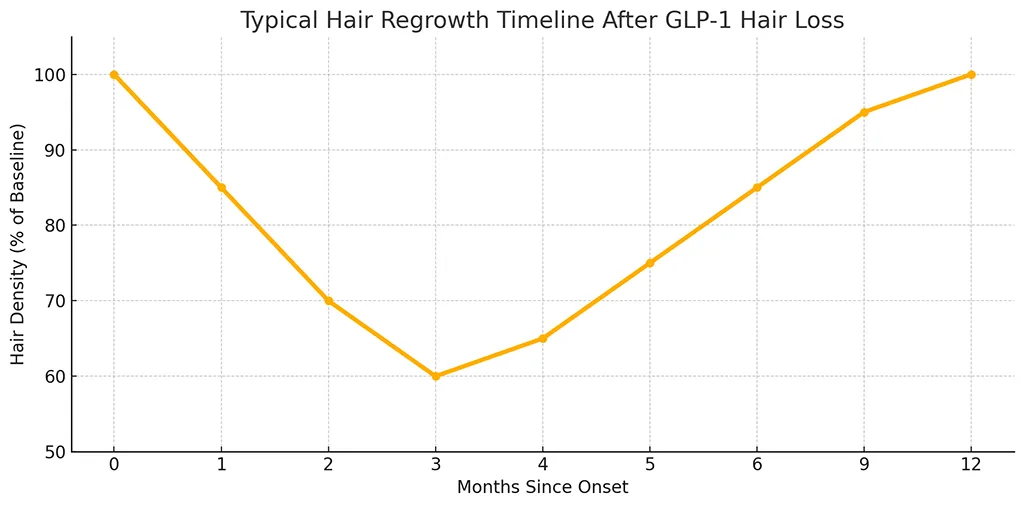
Rule Out Other Causes: It doesn’t hurt to have a check-up. Sometimes multiple factors stack up. For example, if you happen to have low thyroid or an autoimmune condition, that could cause hair loss too. A doctor can run labs (thyroid, iron, etc.)Cleveland Clinic
to see if something else needs treatment. If your iron is low, treating that (with supplements) can help your hair tremendously. If it truly is just the weight-loss effect, then at least you know and won’t be chasing other explanations.
Topical Minoxidil (Rogaine®): This over-the-counter medication is applied to the scalp and can stimulate hair follicles to regrow hair faster. It’s actually the first-line treatment for common hereditary hair thinning, but some dermatologists also suggest it for telogen effluvium to speed up regrowth Cleveland Clinic. It’s not a magic fix and not everyone will want to use it, but it’s an option. If you do choose to try minoxidil, be aware you have to use it daily (and hair might shed a bit more at first as it pushes out old hairs to make way for new). Always follow the product instructions or your doctor’s guidance.
Other Remedies and Supplements: Many people ask about biotin or other hair vitamins. Generally, biotin supplementation hasn’t shown strong evidence of preventing telogen effluvium unless you are actually biotin deficient (which is rare) PMC. However, a standard multivitamin can ensure no deficiencies. Some individuals try collagen peptides, omega-3 fatty acids, or silica for hair health – these are usually harmless, but their benefits are not clearly proven. If it makes you feel proactive, you can try such supplements, but manage expectations. Avoid mega-doses and “miracle” hair pills that are not backed by science.
Cosmetic Measures: In the interim, while waiting for hair to regrow, a few tricks can make a big difference in how your hair looks. Volumizing shampoos and conditioners can give the appearance of fuller hair. A new haircut (shorter, with layers or texture) can make thin hair look thicker – consider consulting a stylist who knows how to work with thinning hair. Scalp-colored hair fibers or powders (available at drugstores) can be sprinkled on to camouflage any wide parts or thin areas (these wash out and are safe to use). It’s also perfectly okay to use wigs, toppers, or extensions if it makes you feel more confident; just be gentle with application to not pull on the hair you do have.
Dermatologist Consultation: If hair loss is severe or you’re just really anxious about it, seeing a dermatologist (especially one who specializes in hair disorders) can be reassuring. They can confirm the diagnosis (often just by examining your scalp and doing a “hair pull test”GOODRX) and guide treatment. In addition to minoxidil, dermatologists might offer treatments like PRP (platelet-rich plasma) injections into the scalp, which have shown some promise in stimulating hair growth Cleveland Clinic. Those tend to be considered in more chronic hair loss situations, but if telogen effluvium unmasked some underlying pattern hair loss, a derm can help manage that too.
Lastly, remember to keep perspective. We know it’s hard when it’s happening to you. But this type of hair loss is almost always reversible. Your hair very likely will come back. In the meantime, remind yourself why you went on the GLP-1 medication in the first place – perhaps to improve your health, reduce health risks, feel better in your body. Those benefits are important and real. And they don’t have to come at the cost of your hair forever.
💡 Fun Fact 💡
To protect your hair during weight loss, aim for sufficient protein (your hair is made of protein!), iron, and other vitamins. Many experts recommend about 60–80 grams of protein per day. This can help minimize hair thinning Cleveland Clinic
Embracing a Healthier You
Hair loss from GLP-1 treatment is usually not permanent. It can be jarring, but it’s manageable. These medications are improving people’s health: helping with diabetes, reducing obesity-related risks, and even boosting confidence as the pounds drop. Those are life-changing benefits. And while no one wants to deal with hair worries, now you’re equipped with knowledge and tools to address it without panic or shame.
In Summary: If you’re on a GLP-1 journey and notice some hair thinning, don’t be afraid. Be proactive. Take care of your nutrition, talk with your healthcare team, and consider simple interventions to support your hair. Most importantly, know that you’re not alone and not at fault. This is a well-recognized phenomenon and it often reverses in timeNBCNEWS.
With the right guidance, you can continue your treatment with confidence and look forward to both a healthier body and healthy hair in the long run.
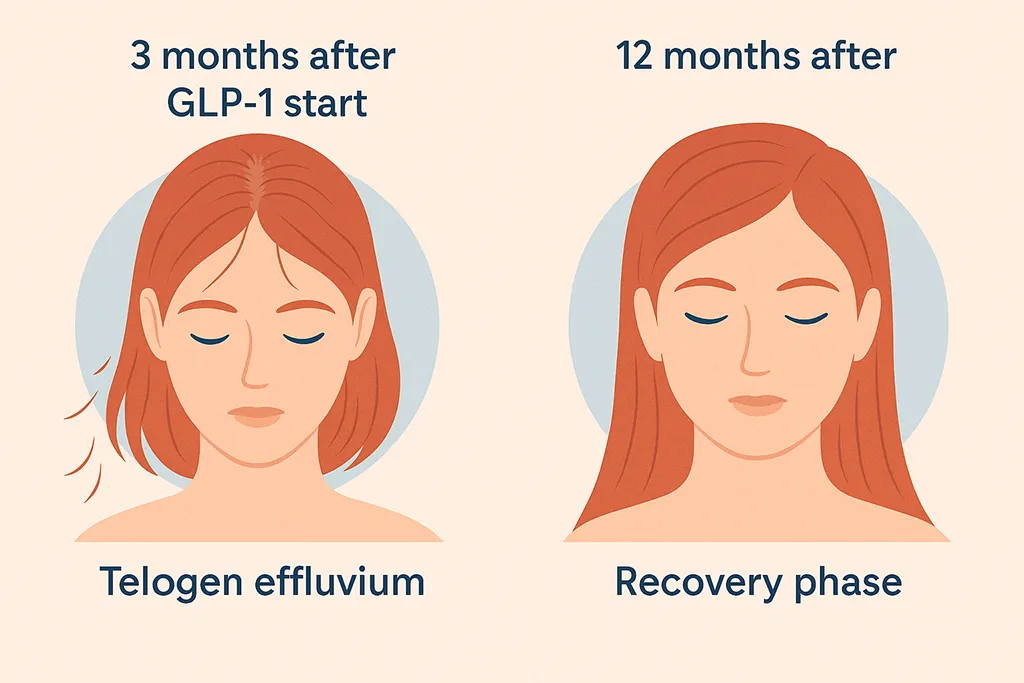
Disclaimer: This article is intended for informational purposes. It is not medical advice. Consult a healthcare professional for guidance on weight loss or any medical treatment.
Cited Sources
StatPearls (NCBI). Male and Female Pattern Hair Loss. PMC
National Council on Aging. Hair Loss Facts & Statistics. NCOA
NBC News. Weight‑Loss Drugs and Hair Loss. NBCNEWS
ResearchGate. Dermatologic Side Effects of GLP‑1 Medications. RESEARCHGATE
PubMed. Pharmacovigilance Analysis of Hair‑Loss Reports with GLP‑1 RAs. PUBMED
FDA. Potential Safety Signal: Alopecia in GLP‑1 Users (FAERS Q3 2023). FDA
PubMed. Retrospective Cohort Study on GLP‑1–Associated Alopecia. PUBMED
GoodRx. Telogen Effluvium: Causes and Timeline. GOODRX
PubMed. Hair Loss After Metabolic and Bariatric Surgery. PUBMED
Cleveland Clinic. Hair Loss: Overview, Causes and Prevention. Cleveland Clinic
EMA. Wegovy (Semaglutide) Product Information. EMA
Healthline. Saxenda: Side Effects and How to Manage Them. HEALTHLINE
medRxiv Preprint. Semaglutide and Hair‑Loss Risk: A Retrospective Analysis. MEDRXIV
StatPearls (NCBI). Vitamin Toxicity and Hair Loss. PMC








